Towards Improved Flash Flood Forecasting over Dire Dawa, Ethiopia Using WRF-Hydro
Abstract
:1. Introduction
2. Domain, Data and Model Description
2.1. Study Area
2.2. Observational and Gridded Datasets
2.3. Model Description
2.3.1. WRF Model
2.3.2. WRF-Hydro Model
2.4. Runoff Generation and Infiltration
2.5. Model Performance Evaluation Metrics
3. Results and Discussion
3.1. Calibration of the Uncopuled WRF-Hydro Model
3.2. Case Study I (March 2005)
3.2.1. Extreme Precipitation Event and Its Association with Circulation Anomalies
3.2.2. WRF-Hydro Simulation for the Case Study of March 2005
3.3. Case Study II (April 2007)
3.3.1. Climatological Perspectives for the Case of April 2007
3.3.2. WRF-Hydro Simulation for the Case Study of April 2007
3.4. Limitations of the Simulations
4. Summary and Conclusions
Author Contributions
Funding
Acknowledgments
Conflicts of Interest
Appendix A
Appendix A.1. Surface Infiltration
Appendix A.2. Model Performance Evaluation
Appendix A.3. Supplementary Figures
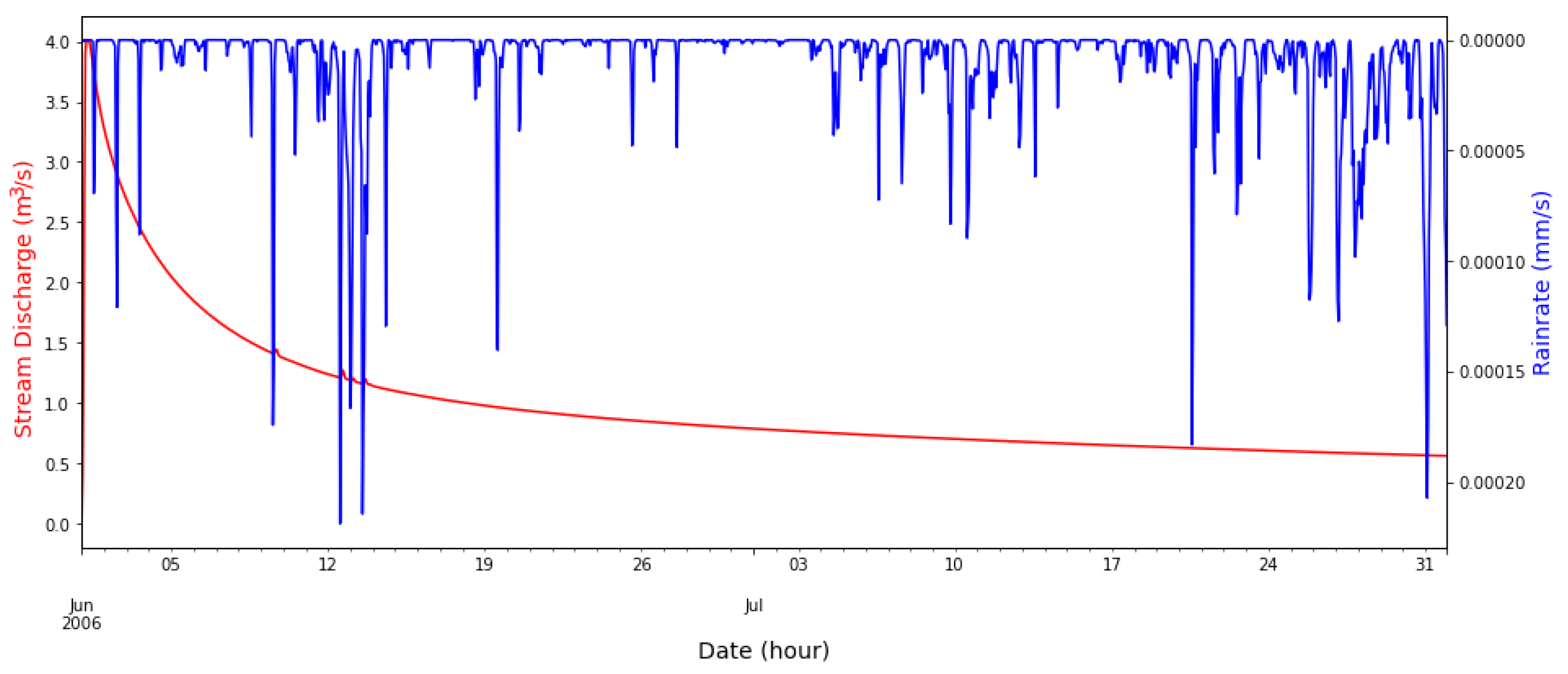


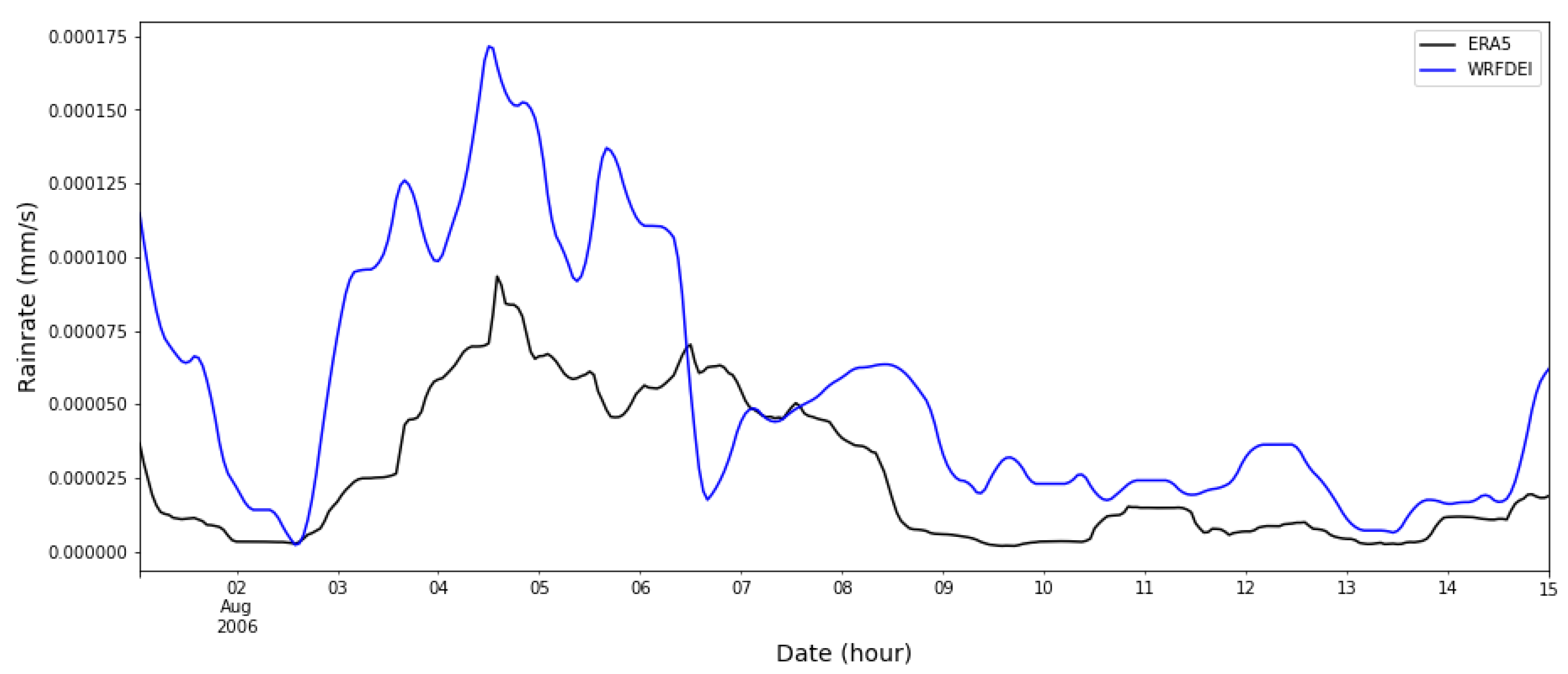
| References | Key Findings | Gap Identified |
|---|---|---|
| Maidment 2017 [21] | Presents a conceptual framework to connect information from high-resolution flood forecasting with real-time observations | It is not fully distributed and could not capture surface heterogeneity |
| Camera et al. (2020) [23], Silver et al. (2017) [25], Chowdhury et al. (2023) [26] and Xu et al. (2023) [27] | High-resolution land-surface-based hydrological models are able to simulate the pick, timing and spatial distribution of flood events reasonably | Large-scale atmospheric circulations associated with heavy precipitation were not investigated. All the studies were not conducted in East African region |
| Lahmers et al. (2015) [28] and Lahmers et al. (2019) [24], Cerbelaud et al. (2022) [29] | The uncoupled WRF-Hydro model can accurately simulate streamflow and pick, timing and spatial distribution of flood events when calibrated for specific river basins (Gile River and Babocomari River basins) in southern Arizona, across six watersheds in New Caledonia’s tropical island (SW Pacific) | Investigations into large-scale atmospheric circulations linked to intense precipitation have been limited, and none of the studies have specifically focused on the East African region. |
| Kerandi et al. (2018) [30] | WRF-Hydro used to quantify the terrestrial water balance over the Tana River basin in East | Large-scale atmospheric circulations associated with heavy precipitation were not investigated. |
| Givati et al. (2014) [35] and Krajewski et al. (2017) [34] | WRF-Hydro used operationally for flood forecasting over the US and Israel | Operational flood forecasting was not applied in East African region |
| Shanko et al. (1998) [37], Segele et al. (2009) [36], Diro et al. (2011) [38], Viste and Sorteberg (2013) [40], Zeleke et al. (2017) [41] and Bekele-Biratu et al. (2018) [39] | The dynamics of large-scale climate drivers like the Indian Ocean Dipole and Madden–Julian Oscillation and others can influence heavy precipitation at sub-seasonal and seasonal time scale | Flash flood forecasting was not conducted in these studies |
References
- Diaz, J.H. The public health impact of hurricanes and major flooding. J. La. State Med. Soc. Off. Organ La. State Med. Soc. 2004, 156, 145–150. [Google Scholar]
- Noji, E.K. Natural disasters. Crit. Care Clin. 1991, 7, 271–292. [Google Scholar] [CrossRef] [PubMed]
- Tramblay, Y.; Villarini, G.; Zhang, W. Observed changes in flood hazard in Africa. Environ. Res. Lett. 2020, 15, 1040b5. [Google Scholar] [CrossRef]
- Berghuijs, W.R.; Aalbers, E.E.; Larsen, J.R.; Trancoso, R.; Woods, R.A. Recent changes in extreme floods across multiple continents. Environ. Res. Lett. 2017, 12, 114035. [Google Scholar] [CrossRef]
- Kale, V.S. Is flooding in S outh A sia getting worse and more frequent? Singap. J. Trop. Geogr. 2014, 35, 161–178. [Google Scholar] [CrossRef]
- Shrestha, M.S.; Takara, K. Impacts of floods in South Asia. J. South Asia Disaster Study 2008, 1, 85–106. [Google Scholar]
- FitzGerald, G.; Du, W.; Jamal, A.; Clark, M.; Hou, X.Y. Flood fatalities in contemporary Australia (1997–2008). Emerg. Med. Australas. 2010, 22, 180–186. [Google Scholar] [CrossRef]
- Nations, U. World urbanization prospects: The 2001 revision. Data tables and highlights. In World Urban Prospect 2003 Revis; 2002; pp. 1–195. Available online: http://www.megacities.uni-koeln.de/documentation/megacity/statistic/wup2001dh.pdf (accessed on 1 May 2023).
- Alderman, K.; Turner, L.R.; Tong, S. Floods and human health: A systematic review. Environ. Int. 2012, 47, 37–47. [Google Scholar] [CrossRef]
- Di Baldassarre, G.; Montanari, A.; Lins, H.; Koutsoyiannis, D.; Brandimarte, L.; Blöschl, G. Flood fatalities in Africa: From diagnosis to mitigation. Geophys. Res. Lett. 2010, 37. [Google Scholar] [CrossRef]
- Billi, P.; Alemu, Y.T.; Ciampalini, R. Increased frequency of flash floods in Dire Dawa, Ethiopia: Change in rainfall intensity or human impact. Nat. Hazards 2015, 76, 1373–1394. [Google Scholar] [CrossRef]
- Erena, S.H.; Worku, H. Flood risk analysis: Causes and landscape based mitigation strategies in Dire Dawa city, Ethiopia. Geoenviron. Disasters 2018, 5, 16. [Google Scholar] [CrossRef]
- Erena, S.H.; Worku, H.; De Paola, F. Flood hazard mapping using FLO-2D and local management strategies of Dire Dawa city, Ethiopia. J. Hydrol. Reg. Stud. 2018, 19, 224–239. [Google Scholar] [CrossRef]
- Demessie, D.A. Assessment of Flood Risk in Dire Dawa Town, Eastern Ethiopia, Using Gis. Ph.D. Thesis, Addis Ababa University, Addis Ababa, Ethiopia, 2007. [Google Scholar]
- Douglas, I.; Alam, K.; Maghenda, M.; Mcdonnell, Y.; McLean, L.; Campbell, J. Unjust waters: Climate change, flooding and the urban poor in Africa. Environ. Urban. 2008, 20, 187–205. [Google Scholar] [CrossRef]
- Olivier, J.G.; Van Aardenne, J.A.; Dentener, F.J.; Pagliari, V.; Ganzeveld, L.N.; Peters, J.A. Recent trends in global greenhouse gas emissions: Regional trends 1970–2000 and spatial distributionof key sources in 2000. Environ. Sci. 2005, 2, 81–99. [Google Scholar] [CrossRef]
- Du, H.; Alexander, L.V.; Donat, M.G.; Lippmann, T.; Srivastava, A.; Salinger, J.; Kruger, A.; Choi, G.; He, H.S.; Fujibe, F.; et al. Precipitation from persistent extremes is increasing in most regions and globally. Geophys. Res. Lett. 2019, 46, 6041–6049. [Google Scholar] [CrossRef]
- Myhre, G.; Alterskjær, K.; Stjern, C.W.; Hodnebrog, Ø.; Marelle, L.; Samset, B.H.; Sillmann, J.; Schaller, N.; Fischer, E.; Schulz, M.; et al. Frequency of extreme precipitation increases extensively with event rareness under global warming. Sci. Rep. 2019, 9, 16063. [Google Scholar] [CrossRef]
- Coumou, D.; Robinson, A. Historic and future increase in the global land area affected by monthly heat extremes. Environ. Res. Lett. 2013, 8, 034018. [Google Scholar] [CrossRef]
- Zhang, X.; Alexander, L.; Hegerl, G.C.; Jones, P.; Tank, A.K.; Peterson, T.C.; Trewin, B.; Zwiers, F.W. Indices for monitoring changes in extremes based on daily temperature and precipitation data. Wiley Interdiscip. Rev. Clim. Chang. 2011, 2, 851–870. [Google Scholar] [CrossRef]
- Maidment, D.R. Conceptual framework for the national flood interoperability experiment. JAWRA J. Am. Water Resour. Assoc. 2017, 53, 245–257. [Google Scholar] [CrossRef]
- Usman, M.; Ndehedehe, C.E.; Farah, H.; Ahmad, B.; Wong, Y.; Adeyeri, O.E. Application of a Conceptual Hydrological Model for Streamflow Prediction Using Multi-Source Precipitation Products in a Semi-Arid River Basin. Water 2022, 14, 1260. [Google Scholar] [CrossRef]
- Camera, C.; Bruggeman, A.; Zittis, G.; Sofokleous, I.; Arnault, J. Simulation of extreme rainfall and streamflow events in small Mediterranean watersheds with a one-way-coupled atmospheric–hydrologic modelling system. Nat. Hazards Earth Syst. Sci. 2020, 20, 2791–2810. [Google Scholar]
- Lahmers, T.M.; Gupta, H.; Castro, C.L.; Gochis, D.J.; Yates, D.; Dugger, A.; Goodrich, D.; Hazenberg, P. Enhancing the structure of the WRF-hydro hydrologic model for semiarid environments. J. Hydrometeorol. 2019, 20, 691–714. [Google Scholar] [CrossRef]
- Silver, M.; Karnieli, A.; Ginat, H.; Meiri, E.; Fredj, E. An innovative method for determining hydrological calibration parameters for the WRF-Hydro model in arid regions. Environ. Model. Softw. 2017, 91, 47–69. [Google Scholar]
- Chowdhury, M.E.; Islam, A.S.; Lemans, M.; Hegnauer, M.; Sajib, A.R.; Pieu, N.M.; Das, M.K.; Shadia, N.; Haque, A.; Roy, B.; et al. An efficient flash flood forecasting system for the un-gaged Meghna basin using open source platform Delft-FEWS. Environ. Model. Softw. 2023, 161, 105614. [Google Scholar] [CrossRef]
- Xu, Y.; Jiang, Z.; Liu, Y.; Zhang, L.; Yang, J.; Shu, H. An adaptive ensemble framework for flood forecasting and its application in a small watershed using distinct rainfall interpolation methods. Water Resour. Manag. 2023, 37, 2195–2219. [Google Scholar] [CrossRef]
- Lahmers, T.; Castro, C.L.; Gupta, H.V.; Gochis, D.J.; ElSaadani, M. Optimization of precipitation and streamflow forecasts in the southwest Contiguous US for warm season convection. In Proceedings of the AGU Fall Meeting Abstracts, San Francisco, CA, USA, 14–18 December 2015; Volume 2015, p. H53A-1650. [Google Scholar]
- Cerbelaud, A.; Lefèvre, J.; Genthon, P.; Menkes, C. Assessment of the WRF-Hydro uncoupled hydro-meteorological model on flashy watersheds of the Grande Terre tropical island of New Caledonia (South-West Pacific). J. Hydrol. Reg. Stud. 2022, 40, 101003. [Google Scholar] [CrossRef]
- Kerandi, N.; Arnault, J.; Laux, P.; Wagner, S.; Kitheka, J.; Kunstmann, H. Joint atmospheric-terrestrial water balances for East Africa: A WRF-Hydro case study for the upper Tana River basin. Theor. Appl. Climatol. 2018, 131, 1337–1355. [Google Scholar] [CrossRef]
- Senatore, A.; Furnari, L.; Mendicino, G. Impact of high-resolution sea surface temperature representation on the forecast of small Mediterranean catchments’ hydrological responses to heavy precipitation. Hydrol. Earth Syst. Sci. 2020, 24, 269–291. [Google Scholar] [CrossRef]
- Papaioannou, G.; Vasiliades, L.; Loukas, A.; Alamanos, A.; Efstratiadis, A.; Koukouvinos, A.; Tsoukalas, I.; Kossieris, P. A flood inundation modeling approach for urban and rural areas in lake and large-scale river basins. Water 2021, 13, 1264. [Google Scholar] [CrossRef]
- Yucel, I.; Onen, A.; Yilmaz, K.; Gochis, D. Calibration and evaluation of a flood forecasting system: Utility of numerical weather prediction model, data assimilation and satellite-based rainfall. J. Hydrol. 2015, 523, 49–66. [Google Scholar] [CrossRef]
- Krajewski, W.F.; Ceynar, D.; Demir, I.; Goska, R.; Kruger, A.; Langel, C.; Mantilla, R.; Niemeier, J.; Quintero, F.; Seo, B.C.; et al. Real-time flood forecasting and information system for the state of Iowa. Bull. Am. Meteorol. Soc. 2017, 98, 539–554. [Google Scholar] [CrossRef]
- Givati, A.; Sapir, G. Simulating 1% Probability Hydrograph at the Ayalon Basin Using the HEC-HMS; Special Hydrological Report; Israel Hydrological Service: Jerusalem, Israel, 2014. [Google Scholar]
- Segele, Z.T.; Lamb, P.J.; Leslie, L.M. Large-scale atmospheric circulation and global sea surface temperature associations with Horn of Africa June–September rainfall. Int. J. Climatol. J. R. Meteorol. Soc. 2009, 29, 1075–1100. [Google Scholar] [CrossRef]
- Shanko, D.; Camberlin, P. The effects of the Southwest Indian Ocean tropical cyclones on Ethiopian drought. Int. J. Climatol. J. R. Meteorol. Soc. 1998, 18, 1373–1388. [Google Scholar] [CrossRef]
- Diro, G.; Grimes, D.I.F.; Black, E. Teleconnections between Ethiopian summer rainfall and sea surface temperature: Part I—Observation and modelling. Clim. Dyn. 2011, 37, 103–119. [Google Scholar] [CrossRef]
- Bekele-Biratu, E.; Thiaw, W.M.; Korecha, D. Sub-seasonal variability of the Belg rains in Ethiopia. Int. J. Climatol. 2018, 38, 2940–2953. [Google Scholar] [CrossRef]
- Viste, E.; Sorteberg, A. Moisture transport into the Ethiopian highlands. Int. J. Climatol. 2013, 33, 249–263. [Google Scholar] [CrossRef]
- Zeleke, T.T.; Giorgi, F.; Diro, G.; Zaitchik, B. Trend and periodicity of drought over Ethiopia. Int. J. Climatol. 2017, 37, 4733–4748. [Google Scholar] [CrossRef]
- Diro, G.T.; Grimes, D.; Black, E. Large scale features affecting Ethiopian rainfall. In African Climate and Climate Change; Springer: Berlin/Heidelberg, Germany, 2011; pp. 13–50. [Google Scholar]
- Austin, G.L.; Dirks, K.N. Topographic effects on precipitation. In Encyclopedia of Hydrological Sciences; Wiley Online Library: Hoboken, NJ, USA, 2006. [Google Scholar]
- Hersbach, H.; Dee, D. ERA5 reanalysis is in production. ECMWF Newsl. 2016, 147. Available online: https://www.ecmwf.int/en/newsletter/147/news/era5-reanalysis-production (accessed on 1 March 2022).
- Funk, C.; Peterson, P.; Landsfeld, M.; Pedreros, D.; Verdin, J.; Shukla, S.; Husak, G.; Rowland, J.; Harrison, L.; Hoell, A.; et al. The climate hazards infrared precipitation with stations—A new environmental record for monitoring extremes. Sci. Data 2015, 2, 150066. [Google Scholar] [CrossRef]
- Schneider, U.; Becker, A.; Finger, P.; Meyer-Christoffer, A.; Ziese, M.; Rudolf, B. GPCC’s new land surface precipitation climatology based on quality-controlled in situ data and its role in quantifying the global water cycle. Theor. Appl. Climatol. 2014, 115, 15–40. [Google Scholar] [CrossRef]
- Amatulli, G.; Domisch, S.; Tuanmu, M.N.; Parmentier, B.; Ranipeta, A.; Malczyk, J.; Jetz, W. A suite of global, cross-scale topographic variables for environmental and biodiversity modeling. Sci. Data 2018, 5, 180040. [Google Scholar] [CrossRef] [PubMed]
- Danielson, J.J.; Gesch, D. Global Multi-Resolution Terrain Elevation Data 2010 (GMTED2010); US Department of the Interior, US Geological Survey: Reston, VA, USA, 2011; p. 26. [Google Scholar]
- Jarvis, A.; Reuter, H.I.; Nelson, A.; Guevara, E. Hole-filled seamless SRTM data V3. International Centre for Tropical Agriculture (CIAT). 2006. Available online: http://srtm.csi.cgiar.org (accessed on 1 July 2021).
- Skamarock, W.C.; Klemp, J.B.; Dudhia, J.; Gill, D.O.; Liu, Z.; Berner, J.; Wang, W.; Powers, J.G.; Duda, M.G.; Barker, D.M.; et al. A Description of the Advanced Research WRF Model Version 4; National Center for Atmospheric Research: Boulder, CO, USA, 2019; Volume 145, p. 145. [Google Scholar]
- Kim, S.; Shen, H.; Noh, S.; Seo, D.J.; Welles, E.; Pelgrim, E.; Weerts, A.; Lyons, E.; Philips, B. High-resolution modeling and prediction of urban floods using WRF-Hydro and data assimilation. J. Hydrol. 2021, 598, 126236. [Google Scholar] [CrossRef]
- NCEP; FNL. Operational Model Global Tropospheric Analyses, Continuing from July 1999. Res. Data Arch. Natl. Cent. Atmos. Res. Comput. Inf. Syst. Lab. 2000, 10, D6M043C6. [Google Scholar]
- Gochis, D.; Yu, W.; Yates, D. WRF-Hydro Model Technical Description and User’s Guide, Version 3.0. NCAR Technical Document. 120p. Available online: https://ral.ucar.edu/projects/wrf_hydro/technicaldescription-user-guide (accessed on 1 July 2021).
- Schaake, J.C.; Koren, V.I.; Duan, Q.Y.; Mitchell, K.; Chen, F. Simple water balance model for estimating runoff at different spatial and temporal scales. J. Geophys. Res. Atmos. 1996, 101, 7461–7475. [Google Scholar] [CrossRef]
- Chen, F.; Dudhia, J. Coupling an advanced land surface–hydrology model with the Penn State–NCAR MM5 modeling system. Part I: Model implementation and sensitivity. Mon. Weather. Rev. 2001, 129, 569–585. [Google Scholar] [CrossRef]
- Moriasi, D.N.; Arnold, J.G.; Van Liew, M.W.; Bingner, R.L.; Harmel, R.D.; Veith, T.L. Model evaluation guidelines for systematic quantification of accuracy in watershed simulations. Trans. ASABE 2007, 50, 885–900. [Google Scholar] [CrossRef]
- Jonkman, S.N. Global perspectives on loss of human life caused by floods. Nat. Hazards 2005, 34, 151–175. [Google Scholar] [CrossRef]
- Re, M. Natural Catastrophes 2006: Analyses, Assessments; Munich Re Publications: Munich, Germany, 2007. [Google Scholar]
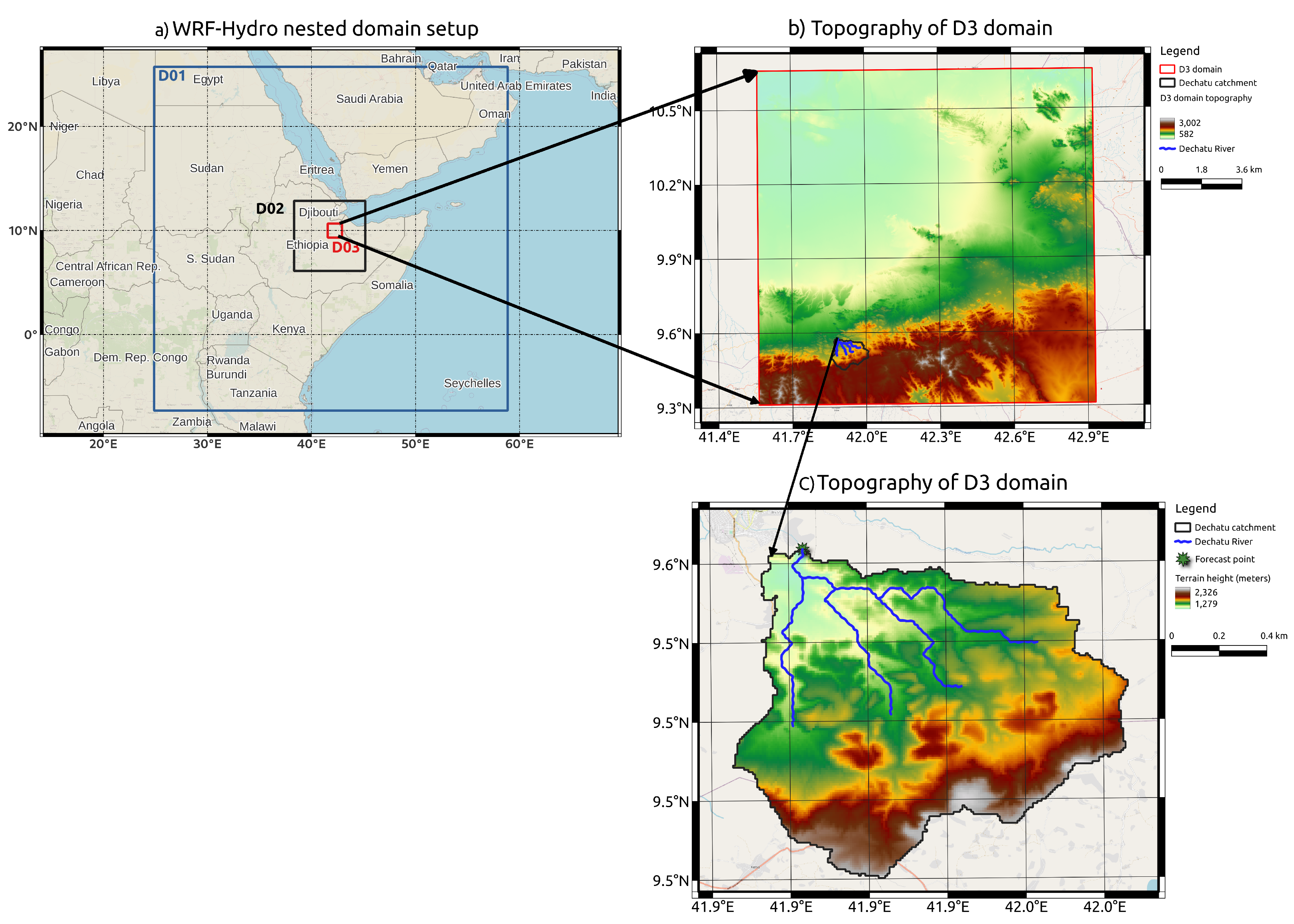
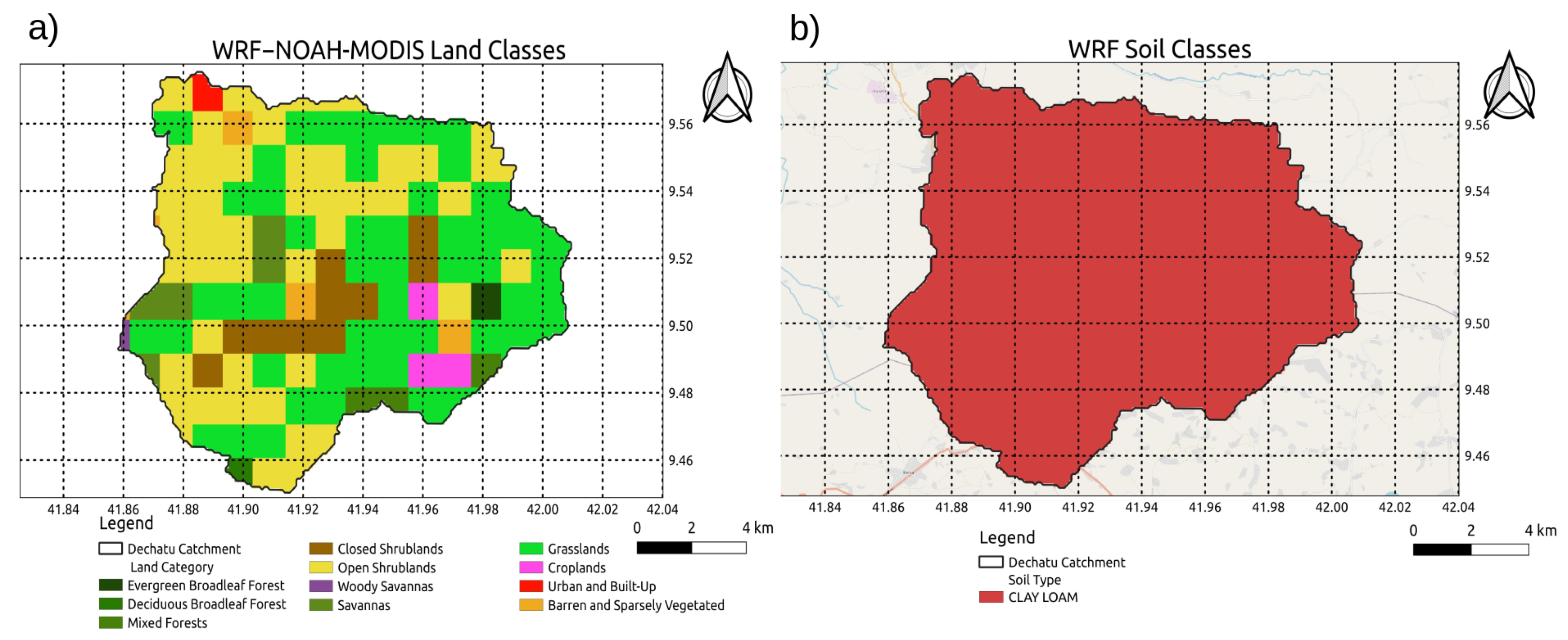
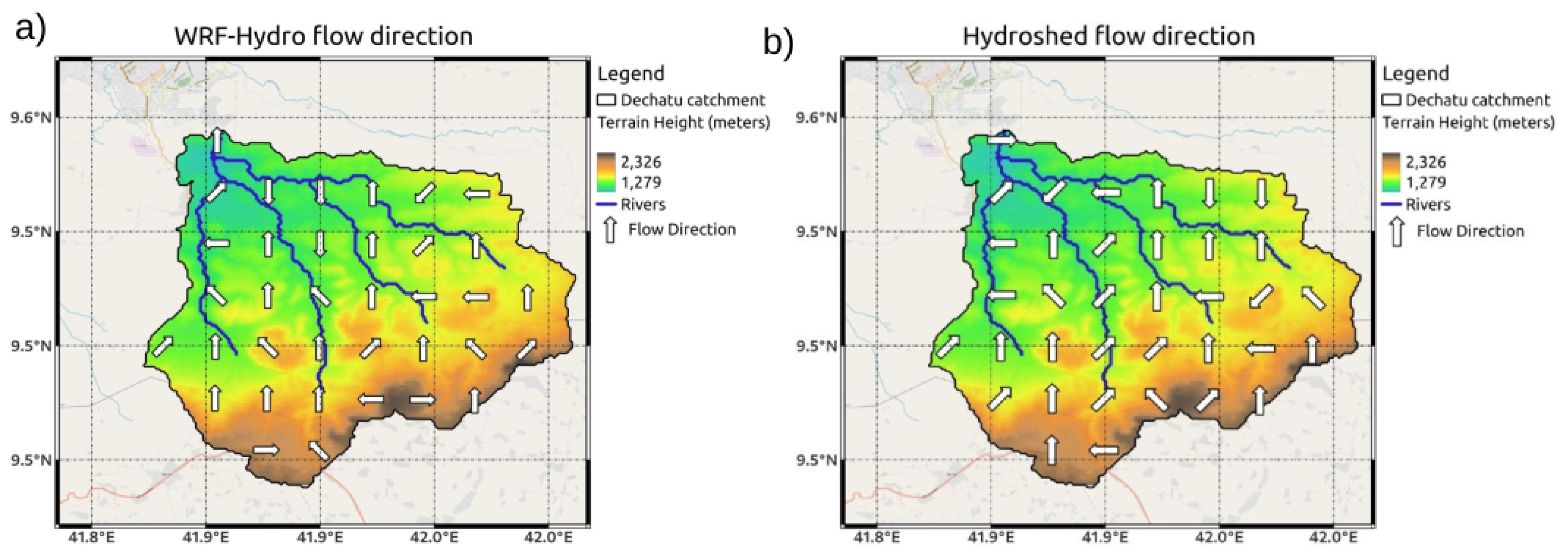
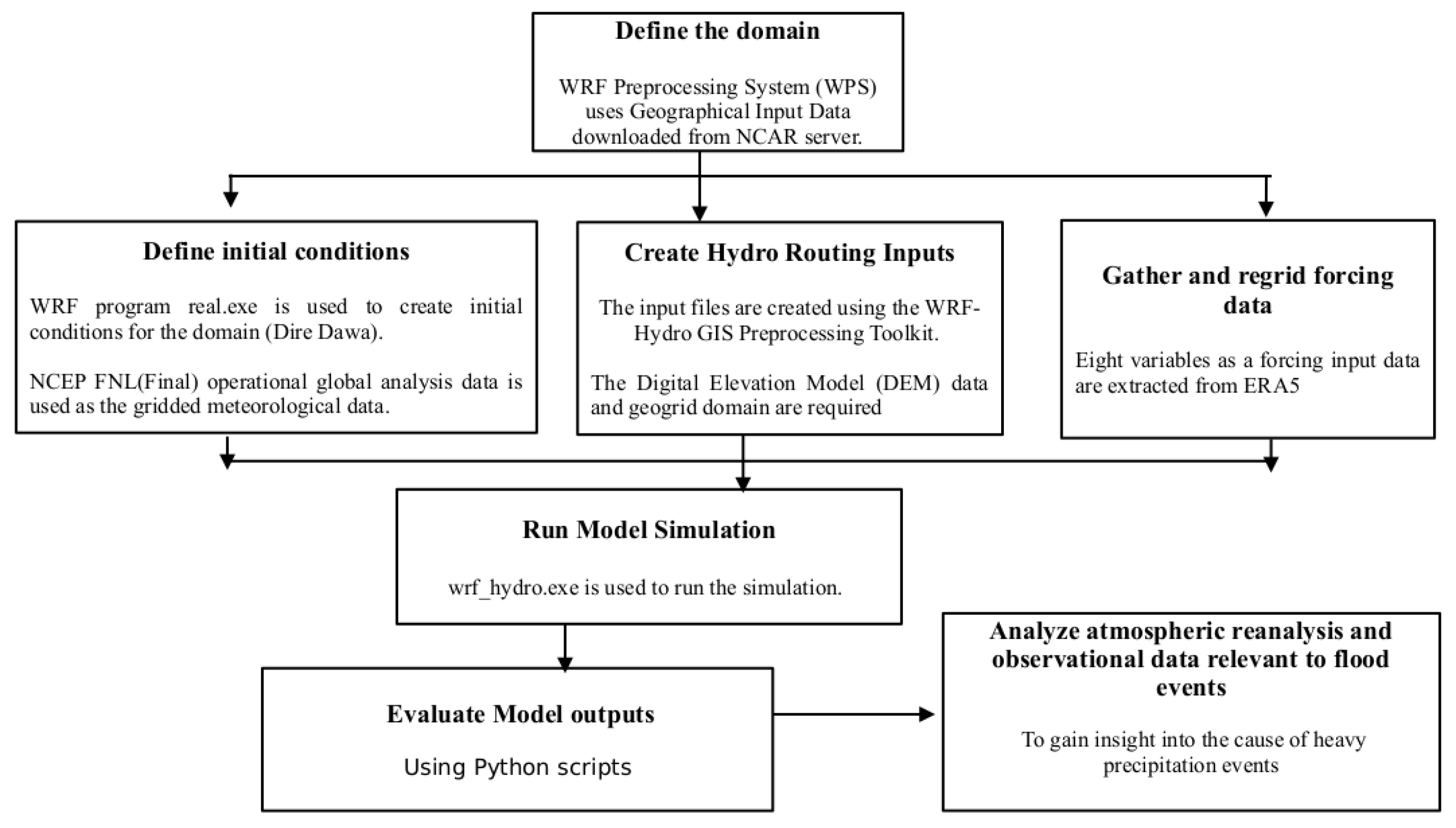


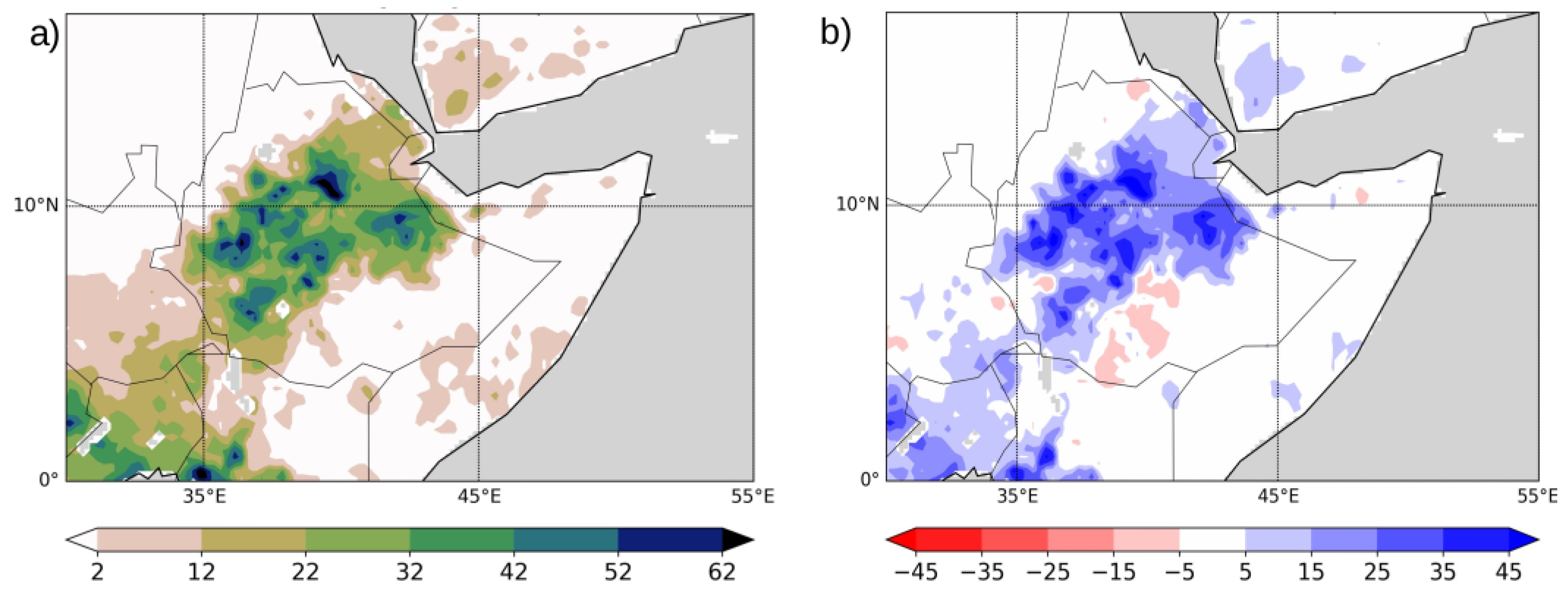
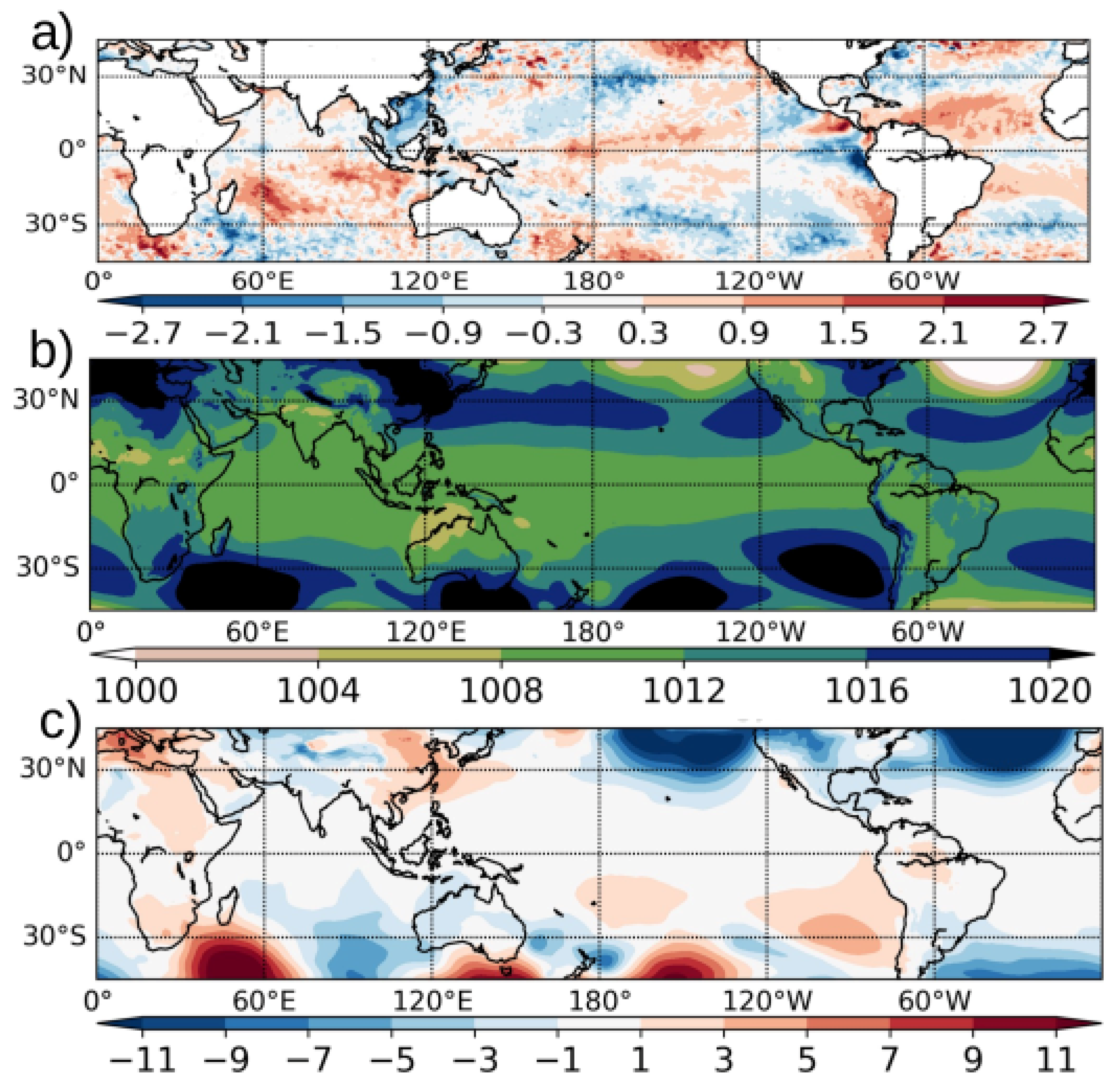
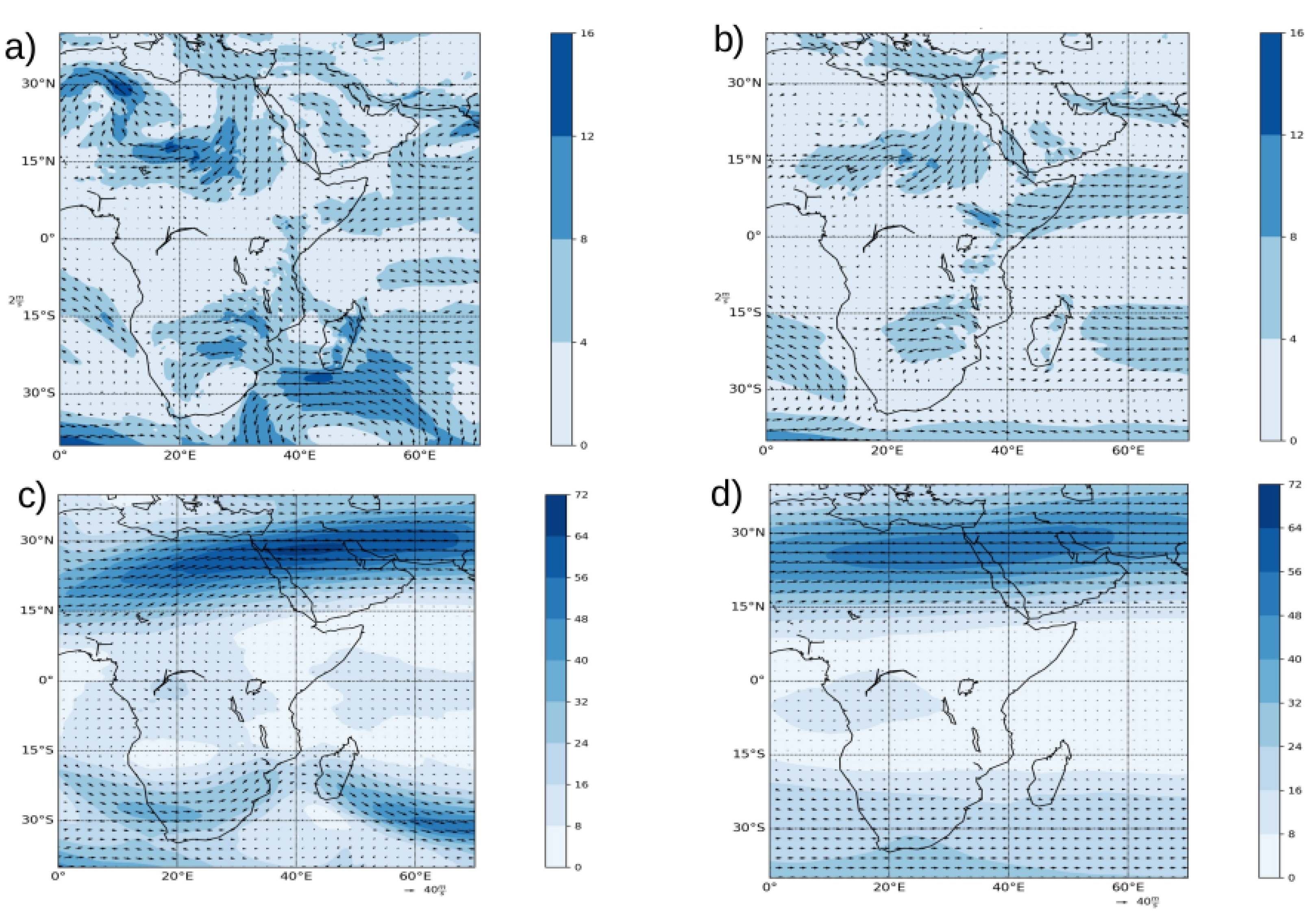

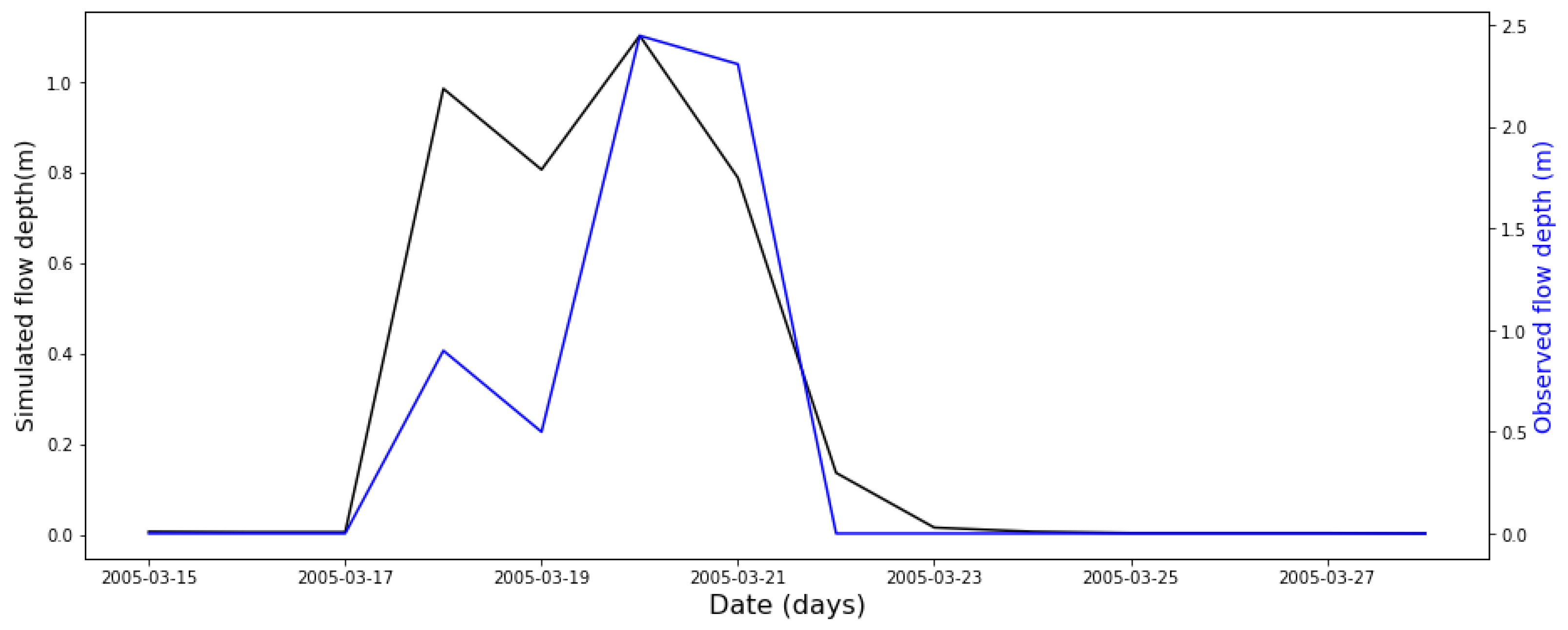
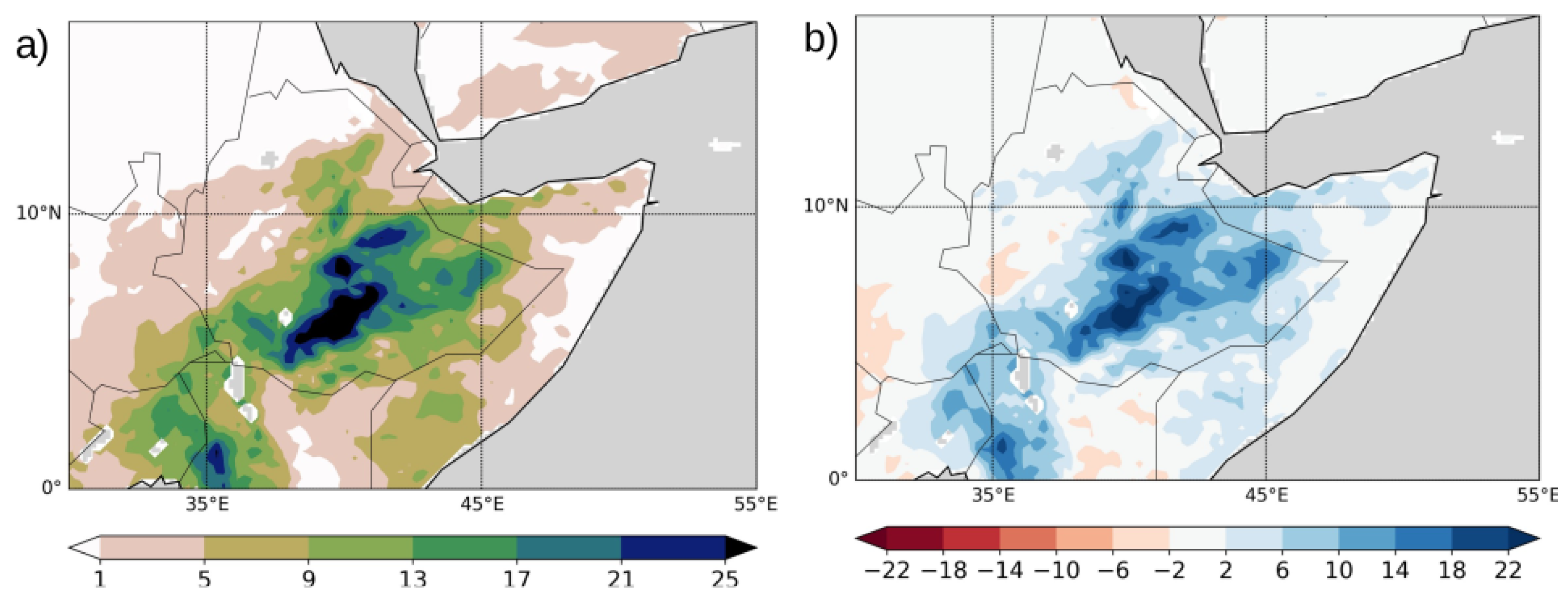
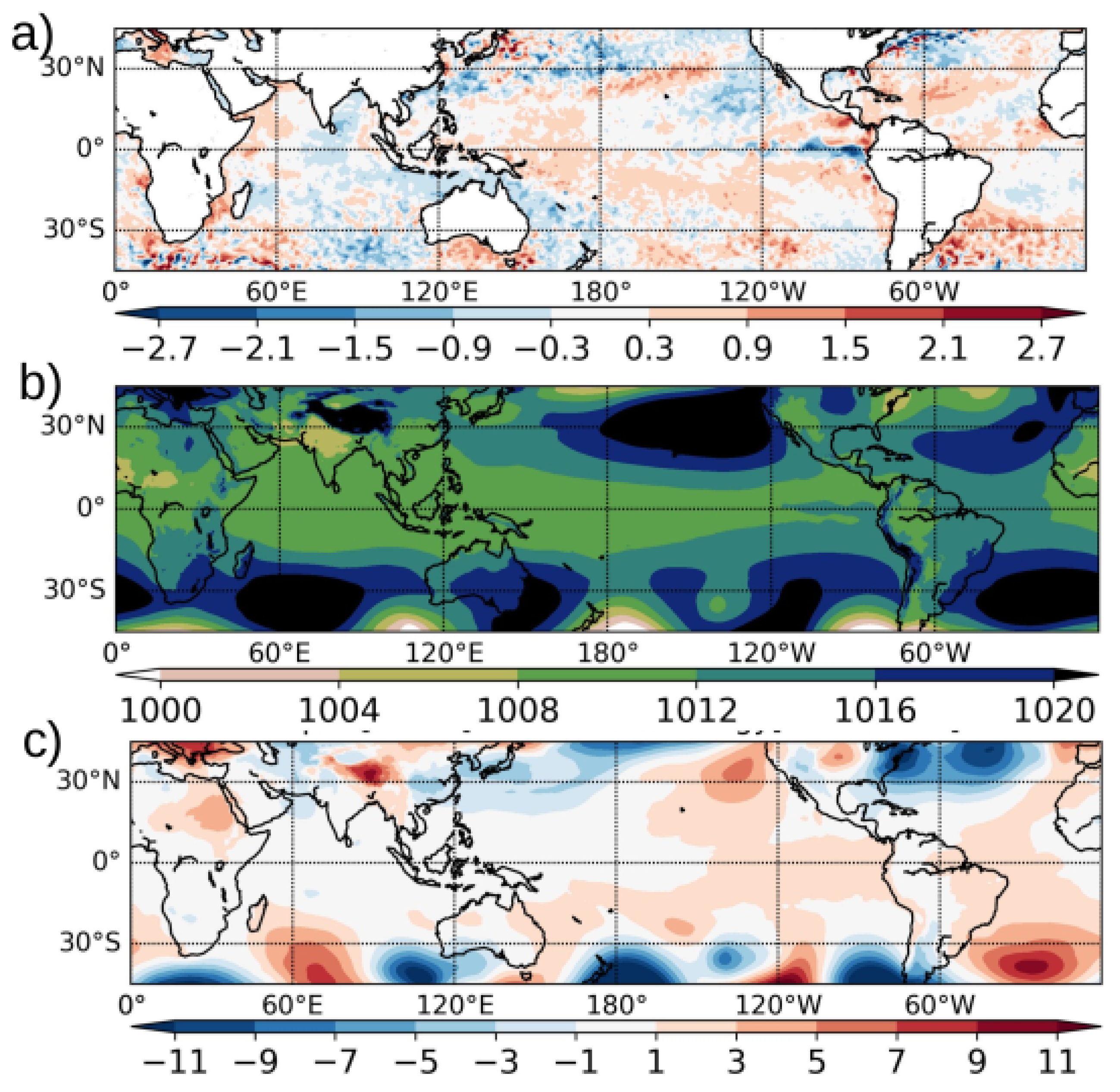

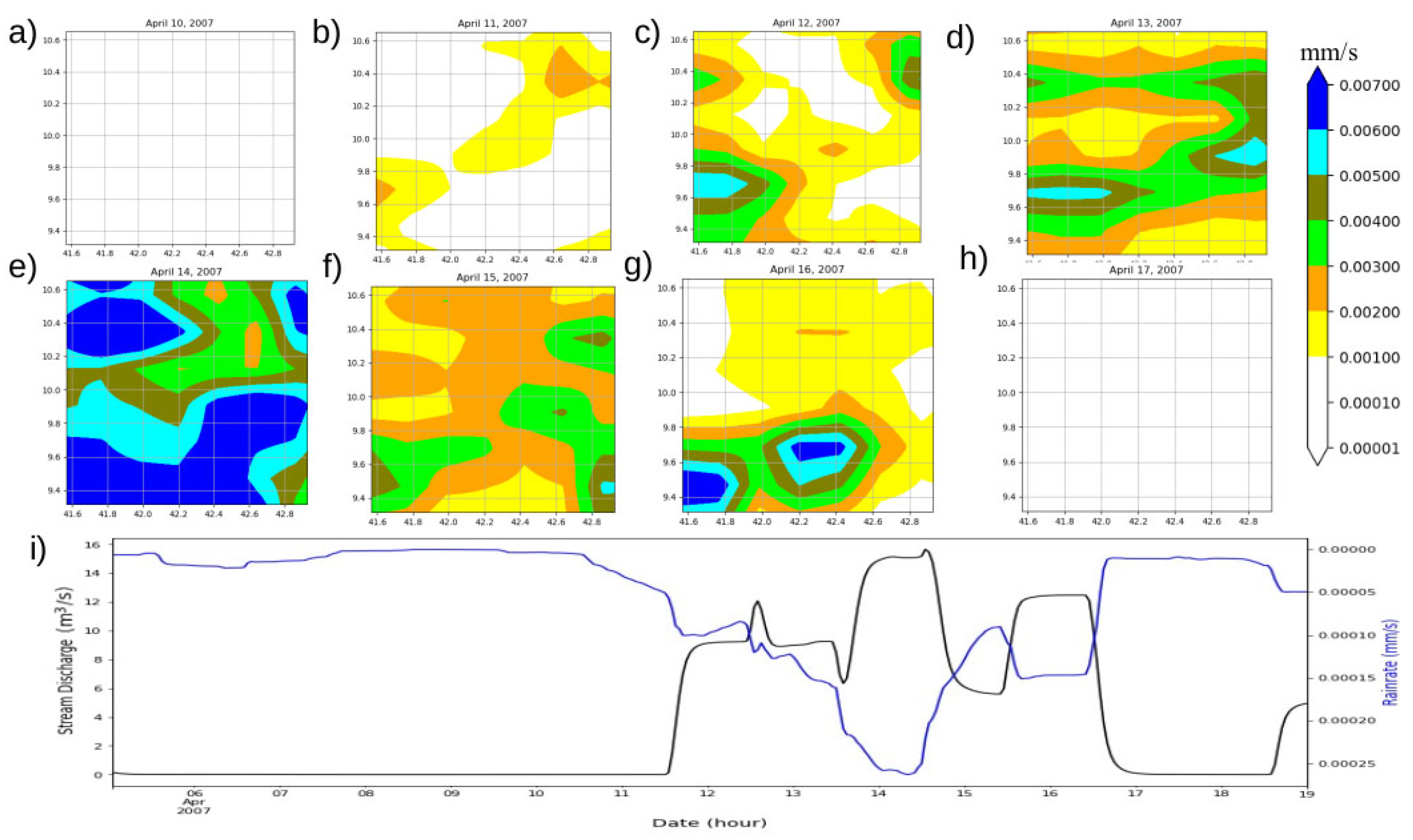

| Namelist Parameter | Chosen Option |
|---|---|
| Number of nested domains | 3 |
| Horizontal resolution | 25 km, 5 km and 1 km |
| Horizontal grid number | 150 × 150 grids for D1, D2 and D3 |
| Integration time-step | 100 s for D1 |
| Projection resolution | Mercator |
| Vertical layers | 34 |
| Microphysics sheme | New Thompson et al. Scheme |
| Cumulus convection | Kain–Fritsch (KF) for D1, no convection scheme for D2 and D3 |
| Planetary boundary layer | Yonsei University Scheme |
| Longwave radiation | RRTMG |
| Shortwave radiation | RRTMG |
| Land Surface Sheme | 5–layer Thermal Diffusion Scheme |
| Land use | Modis |
| Surface layer | Revised MM5 Scheme |
| Processes | Option ID in WRF-Hydro | Description |
|---|---|---|
| DYNAMIC_VEG_OPTION | 4 | Using monthly LAI is prescribed for various vegetation types |
| CANOPY_STOMATAL_RESISTANCE OPTION | 1 | Ball–Berry Canopy stomatal resistance |
| BTR_OPTION | 1 | Noah type using soil moisture for stomatal resistance |
| RUNOFF_OPTION | 3 | Noah type surface and subsurface runoff (free drainage) |
| SURFACE_DRAG_OPTION | 1 | Monin–Obukhov |
| FROZEN_SOIL_OPTION | 1 | Using the total soil moisture to compute hydraulic properties |
| SUPERCOOLED_WATER_OPTION | 1 | No iteration (form of the freezing-point depression equation) |
| RADIATIVE_TRANSFER_OPTION | 3 | Two-stream applied to vegetated fraction |
| SNOW_ALBEDO_OPTION | 2 | BATS |
| PCP_PARTITION_OPTION | 1 | Jordan (1991) |
| TBOT_OPTION | 2 | TBOT at ZBOT (8 m) read from a file |
| TEMP_TIME_SCHEME_OPTION | 3 | Semi-implicit; flux top boundary condition, but FSNO for TS calculation |
| GLACIER_OPTION | 2 | Ice treatment more like original Noah |
| SURFACE_RESISTANCE_OPTION | 4 | For non-snow; rsurf = rsurf_snow for snow (set in MPTABLE) |
| REFKDT | ||||||
| Vaules | 0.1 | 0.3 | 0.5 | 1 | 2 | 3 |
| NSE | 0.324 | 0.259 | 0.138 | −0.01 | −0.085 | −0.086 |
| RMSE | 0.346 | 0.363 | 0.391 | 0.424 | 0.439 | 0.439 |
| RSE | 0.822 | 0.861 | 0.928 | 1.005 | 1.042 | 1.042 |
| DKSAT | ||||||
| Values | 0.3 | 0.5 | 0.7 | 1 | 1.5 | 2 |
| NSE | 0.051 | 0.214 | 0.286 | 0.324 | 0.335 | 0.32 |
| RMSE | 0.41 | 0.374 | 0.356 | 0.346 | 0.344 | 0.347 |
| RSE | 0.974 | 0.887 | 0.845 | 0.822 | 0.816 | 0.825 |
| SMCMAX | ||||||
| Values | 0.75 | 0.9 | 1 | 1.2 | 1.5 | |
| NSE | 0.317 | 0.333 | 0.335 | 0.325 | 0.297 | |
| RMSE | 0.348 | 0.344 | 0.344 | 0.346 | 0.353 | |
| RSE | 0.826 | 0.817 | 0.816 | 0.822 | 0.838 |
Disclaimer/Publisher’s Note: The statements, opinions and data contained in all publications are solely those of the individual author(s) and contributor(s) and not of MDPI and/or the editor(s). MDPI and/or the editor(s) disclaim responsibility for any injury to people or property resulting from any ideas, methods, instructions or products referred to in the content. |
© 2023 by the authors. Licensee MDPI, Basel, Switzerland. This article is an open access article distributed under the terms and conditions of the Creative Commons Attribution (CC BY) license (https://creativecommons.org/licenses/by/4.0/).
Share and Cite
Semie, A.G.; Diro, G.T.; Demissie, T.; Yigezu, Y.M.; Hailu, B. Towards Improved Flash Flood Forecasting over Dire Dawa, Ethiopia Using WRF-Hydro. Water 2023, 15, 3262. https://doi.org/10.3390/w15183262
Semie AG, Diro GT, Demissie T, Yigezu YM, Hailu B. Towards Improved Flash Flood Forecasting over Dire Dawa, Ethiopia Using WRF-Hydro. Water. 2023; 15(18):3262. https://doi.org/10.3390/w15183262
Chicago/Turabian StyleSemie, Addisu G., Gulilat T. Diro, Teferi Demissie, Yonas M. Yigezu, and Binyam Hailu. 2023. "Towards Improved Flash Flood Forecasting over Dire Dawa, Ethiopia Using WRF-Hydro" Water 15, no. 18: 3262. https://doi.org/10.3390/w15183262
APA StyleSemie, A. G., Diro, G. T., Demissie, T., Yigezu, Y. M., & Hailu, B. (2023). Towards Improved Flash Flood Forecasting over Dire Dawa, Ethiopia Using WRF-Hydro. Water, 15(18), 3262. https://doi.org/10.3390/w15183262








